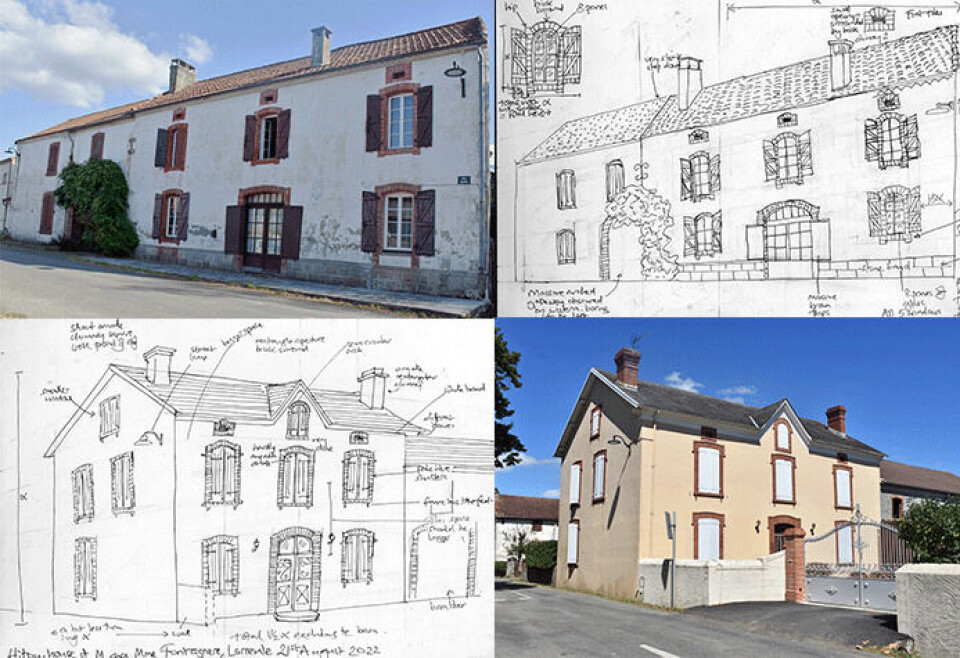-
Large increase in Americans buying properties on the Cote d’Azur
President Trump is cited as a major factor, but is not the only reason for the area’s popularity
-
Is compensation possible if a neighbour’s pet damages garden at French second home?
Disorderly pets can wreak havoc on gardens
-
Repairs on dry stone wall in France: Must stones be bought or can they be picked up?
You may need to consult your neighbour to repair border walls
Drawing will help you get to the essence of a French building
Nick Inman charts the ups and downs of renovating an old French farmhouse

When you restore an old farmhouse, the aim is to do it in the authentic local style.
That is also what planning regulations require you to do when you live in a village with an ancient monument at its heart – in my case, a 12th century abbey church.
I wanted to extend our house from a modest one storey plus attic so that it had a proper upstairs.
This meant adding three gables (pignons), but they had to be in the local style.
Read more: Explained: How to apply for a renovation grant for your French home
What is the local style?
What is our local style? Good question.
I had an interesting but inconclusive discussion with Bâtiments de France about this.
The adviser could tell me what was not acceptable – she knew it when she saw it – but it was harder, even subjective, to say what would be deemed appropriately ‘authentic’.
After that interview, I came to two realisations.
One is that to know what is good you have to look yourself and imagine.
If you do that, it is possible to make modifications to your house that will look as if they were done 200 years ago.
In the case of the gables, the trick was getting the angles of the roof pitch and the curve of the arched window looking right.
It is not always easy to match surrounding buildings.
‘Authentic local style’ a modern concept
Part of the problem is that ‘authentic local style’ is a modern concept.
Back in the 18th century, when our house was built, there was no such thing as a regulation form of building.
All householders had to go on was precedent.
They did what they could with the money and materials they had available, taking inspiration from their neighbours and perhaps improving on it.
I have been getting increasingly interested in this subject.
The more work I do on my house, the more it makes me want to look at the solutions that builders of old adopted.
Photographs only get you so far
Looking and taking photographs gets you so far but there is a better way to really understand why the traditional houses around you are as they are.
Late last summer, I started drawing the oldest houses in the village.
For me, almost every DIY job starts with sketching plans and visualising outcomes, so I have had some practice.
I worked freehand, estimating proportions and spaces because what might be lost in accuracy is made up for by the ‘feel’ of the building.
The funny thing is that when you stare hard at anything and try your best to copy what you see on to paper, you start to understand a lot more about it.
Photography does not get anywhere near the nervous scratch of a pencil and ruthless application of an eraser for getting down to essence.
At the same time as the drawing, I did as much research as I could, dating the houses and giving them their proper ancestral names.
Features evolve over time
Through a combination of reading and observation, I began to see how certain features evolved over time – window panes became bigger, for example.
But there are still some mysteries to solve.
There must once have been a forest of chestnut and oak trees nearby, which supplied the enormous quantity of beams needed to hold up the roofs of a hundred houses.
I had done around 20 drawings when the local councillor in charge of culture asked me to exhibit them in the Mairie for everyone to see.
And there they hang for the moment, encouraging my neighbours to see their houses in different ways and to offer me insights that I have missed.
The project is not yet finished – there are plenty of other houses I want to draw.
I like to think I am creating a sourcebook for anyone who moves into our region and takes on one of these magnificent old houses as a DIY project while keeping as true as possible to the historical style.
Related articles
Community workshops make DIY accessible in France
Leroy Merlin voted France’s favourite DIY shop: do you agree?
French handyman offers home renovations to people in need
























